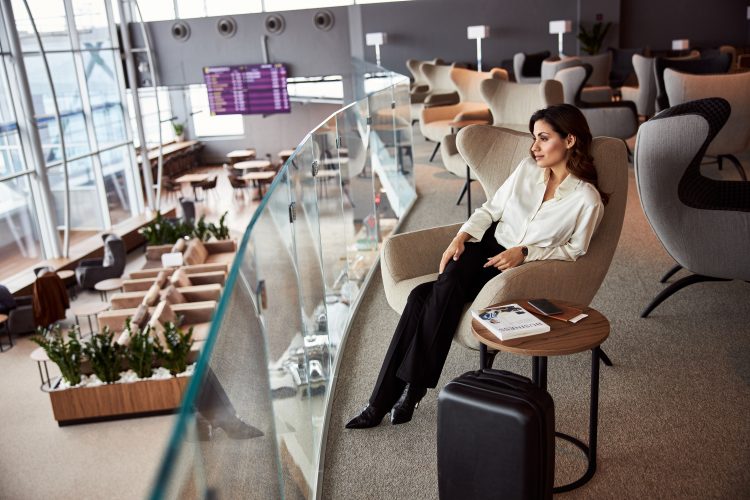How airports use virtual queuing & contactless tech
- Like
- Digg
- Del
- Tumblr
- VKontakte
- Buffer
- Love This
- Odnoklassniki
- Meneame
- Blogger
- Amazon
- Yahoo Mail
- Gmail
- AOL
- Newsvine
- HackerNews
- Evernote
- MySpace
- Mail.ru
- Viadeo
- Line
- Comments
- Yummly
- SMS
- Viber
- Telegram
- Subscribe
- Skype
- Facebook Messenger
- Kakao
- LiveJournal
- Yammer
- Edgar
- Fintel
- Mix
- Instapaper
- Copy Link
Posted: 27 October 2022 | Rezcomm | No comments yet
Virtual queuing and contactless technology help improve health & hygiene standards at the airport but also offer a host of other benefits


How airports use virtual queuing & contactless tech
Contactless technology has been around for a while, but thanks to the COVID-19 pandemic, it has never been as important. It is particularly true in the airport industry, where contactless technology has become crucial in restoring passengers’ confidence in returning to terminals and gaining traction on the long road to recovery.
With the need to improve airport employee and passenger safety, many operators have invested in new touchless technologies, like virtual queuing systems. Not only does this contactless airport technology reduce the number of surfaces people touch at the airport, but it also helps stop crowds from gathering, thus helping to prevent the spread of COVID-19 and other viruses.
Virtual queuing and contactless technology’s health and hygiene benefits are apparent. But you might be interested to hear it has much more to offer. Here we will discuss how virtual queuing and contactless technology is used at airports to improve efficiency, create a positive passenger experience and help protect the industry against future uncertainties.
What is contactless technology?
When you think of contactless technology, what springs to mind? For many people, it’s the contactless payment systems that use Near Field Communications. But this isn’t the only technology that is contactless. Other simple examples you likely use daily include:
● Automatic doors that use gesture recognition
● Touchless toilet flushes
● Tap faucets and hand dryers that use a sensor
● Voice-activated virtual assistant technology
● Facial recognition to unlock smartphones
You’ll also find many examples of touchless technology at the airport, including biometrics, QR codes and virtual queuing systems. Below we’ve shared how airports have integrated this technology into their passenger journeys.
8 examples of airport contactless technology
1. Online check-in
Today, many airports offer contactless check-in by enabling passengers to do it themselves in the comfort of their own homes. During a panel at the International Airport Review Online Summit, the Director and Head of Airport Operations at Changi Airport International, Lee Hock Lye, explained that his airport benefited from online check-in during the pandemic. He said, “in terms of the arrival and immigration process, it’s more touchless in the sense that you get your clearances through your app before you can arrive in Singapore,” adding that the airport would
continue to use online check-in post-pandemic.
2. Smart baggage kiosks
Self-service bag drops reduce queueing and check-in times at the airport, enabling passengers to enjoy a more stress-free journey. After printing their bag tags and boarding passes (or using a digital alternative), passengers simply visit a smart baggage kiosk at the airport, place their luggage on the belt and scan their boarding pass. It’s quick and easy and gives them more time to shop or enjoy a drink in the lounge.
3. Biometrics
Biometrics technology, like facial recognition, is used by airports to prevent passengers’ passports and documentation from needing to be manually checked at various points in the airport. This contactless airport technology has the potential to replace physical passports and improve time optimisation. However, as pointed out by Michael Eggenschwiler, CEO of Hamburg Airport, at the IAR Online Summit, it can’t work without collaboration among stakeholders. “We’re looking to improve cross-functional data links for check-in, security and boarding. We will have to work together as an industry in the interest of the passenger,” he said.
4. Virtual queuing
Virtual queuing technology, like Rezcomm’s Queueless Journeys module, helps eliminate queues at the airport. Instead of passengers queuing up to check in or get through security, they pre-book a time of arrival and queue virtually. As a result, they can enjoy more time to shop, dine or relax, and when it’s their turn, they are alerted via their smartphones. The great thing about virtual queuing technology is that it can work anywhere queues typically exist in the airport.
5. Contactless fast track
Another way airports implement touchless technology is with fast track lanes, which help prevent queuing and crowding while speeding up passenger processing. Instead of waiting in a queue, passengers can purchase a fast track e-ticket by scanning a QR code at the airport. Once purchased, they can use their e-ticket to enter the fast track lane and enjoy a speedier journey throughout the various airport checkpoints.
6. Pre-order retail & food and beverage
Offering a pre-order or browse-and-buy shopping service as part of your airport ecommerce strategy is a great way to provide passengers with a safer and more efficient experience. Pre-orders can work for airport retail and food and beverage, enabling passengers to click and collect or even enjoy the luxury of gate or lounge delivery. Get in touch with Rezcomm to add this functionality to your airport ecommerce website.
7. Digital customer support
Many airports are currently facing staff shortages and cost-cutting. The worry is that this can lead to a drop in customer service. However, there is a way airports can deliver customer support contact-free and digitally. With a digital customer support portal, passengers simply scan a QR code with their phones and get a direct link to an AI chatbot, which can answer their FAQs. If it can’t, customers can instead reach a remote customer support worker via phone.
Offering Contactless Customer Service improves efficiency, ensures a high level of customer satisfaction, and creates an additional layer of safety for passengers and airport employees.
8. Contactless KPI & feedback
Collecting passenger feedback has never been more critical, and thanks to seamless airport technology like Rezcomm’s KPI & Feedback module, it’s easier than ever before. Airports no longer need employees standing with clipboards, hoping to catch passengers’ attention. Instead, they can use contactless QR code scanning at various touchpoints in the airport (such as after security or outside the airport toilets), encouraging passengers to leave real-time feedback. Add an incentive, such as loyalty points or vouchers to spend in your airport retail stores or coffee shops and collect passengers’ marketing permissions in the process.
The benefits of virtual queuing & contactless technology for airports and passengers
There are many benefits of virtual queuing and contactless technology for airports and passengers, the most obvious being improved hygiene standards. Eliminating the need for passengers to touch surfaces, reducing the number of staff they need to meet face-to-face and preventing overcrowding all help to reduce the risk of COVID-19 and other viruses spreading.
Reduces costs
Virtual queuing and other contactless airport technology also have cost benefits. Airports are under immense pressure to keep costs to a minimum – a topic panellists discussed at the IAR Online Summit in great detail. Head of Airport Operations at Noida International Airport, Anurag Shandiyla, said the COVID-19 pandemic had made airports more “cost-conscious” and encouraged them “to reduce the costs that are not adding to productivity or efficiency.”
Contactless airport technology like Fast Track lanes that require passengers to use e-tickets and facial recognition technology reduce the need for airport staff positioned at each checkpoint to carry out manual verifications. Additionally, contactless customer service, using a digital portal, eliminates the need for customer support desks, enabling airports to save money on staff costs.
Improves efficiency
Another benefit of virtual queuing and contactless airport technology is that it helps increase efficiency. Improving the passenger experience is another top priority for airports, as highlighted by Lee Hock Lye at the IAR Online Summit. Using the example of Changi Airports International, he said they were “looking at how to reduce the travel fiction, meaning the pain [points] for airlines and the passengers passing through.”
Improved efficiency benefits airports and passengers, who can enjoy a quicker, streamlined and stress-free journey. Instead of spending hours queueing at busy times, virtual queuing means they can spend more time enjoying themselves (and spending money) in airport retail stores, coffee shops and restaurants instead. All of this contributes to a more positive passenger experience, which in turn, helps to improve passenger loyalty and create those all-important brand advocates.
Increases non-aeronautical revenue
You might be interested to hear there is a direct connection between queuing and passenger spending. The shorter time passengers spend in queues, the more likely they are to spend more money in airport retail stores. And it’s not hard to understand why. Queuing makes people miserable and stressed, so by reducing or eliminating queues, airports can improve the passenger experience, make passengers happy and get them to spend more money in airport retail and duty-free.
Federica Cabrera, Airport Operations and Customer Experience Manager at Carrasco International Airport gave a great example. During a panel at the IAR Online Summit, he explained that when the airport “measured up to 30 minutes of waiting times, the sales in the stores right after dropped by 30% and on some days up to 50%.” However, after implementing digital technology to reduce wait times up to 10 minutes, “the same stores reached the maximum sales.”
Improves resilience
We want to discuss a final benefit of virtual queueing and contactless technology: improved resilience. Unfortunately, we don’t know if or when another pandemic like COVID-19 will strike. However, with contactless technology like virtual queueing already in place, airports will be well on their way to managing emerging situations better than last time and ensuring a quicker recovery. Essentially, contactless technology can help futureproof airport operations.
Implement contactless technology at your airport with Rezcomm
Ready to experience the benefits of virtual queuing and contactless technology at your airport? Download the Rezcomm Marketplace Brochure and Book a Meeting with our experts to get started.
Related topics
Information technology (IT), Passenger experience and seamless travel, Terminal operations


















